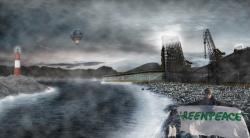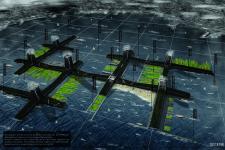SED, the water factory.
There are changes that continuously demand certain adaptation; however, these opportunities to rethink reality have never been too many nor have they had such a global impact. We are witnesses to a cycle closing; we face a scenario of ecological, economic, and social crisis. ¿Which type
of architecture do these new conditions demand? At this point, what is left is the action, being aware of the phenomena is no longer enough. If crisis means opportunity for change, what comes next is evolution, innovation in favor of more sustainable, flexible, diverse, and integrating
architectures.
SED is a typological essay developing in the interdisciplinary scope of ecology, landscape, urbanism, and architecture. It means renovation of
energy infrastructure as well as formulation of new matter and energy management systems and their hybridization with other programs, suggesting a new definition of public sphere.
Today, one third of world population lives in areas with some kind of water shortage, and that proportion is expected to increase to two thirds in
2025 and to three thirds in 2050. According to several research, water usage has increased six times last century, twice the population rise, even though a modest part of global water resources is utilized for human consumption and hygiene (10%). 70% of resources are used to produce food
and the remaining percentage is used in industrial processes, hydroelectricity, and cooling processed for thermal power plants. 97.5% of water in our planet is salty, and only less than 1% is suitable for human consumption.
Desalinating seawater is one potential solution to drinking water shortage.
Desalination plants, known as water factories, are seen as the new alternative to worldwide shortage problems. These plants should approach
environmental and political consequences, and humanitarian problems related to obtaining freshwater for a region. It is known that the employment of chemical methods to get it implies an excessive energy consumption increasing excessively production costs and producing saline
residue, which alters coastal marine ecosystems.
SED/system explores desalination of water via natural methods. Energetically self-sufficing it will spread over maritime platforms of cities that require so as a constant manifestation of what is evident, as a full attribute of reality where what matters is the proceeding which recalls past
mistakes that otherwise would kept hidden. SED system is represented by a symbol, an extension of horizon, a new architecture that not only produces water but also raises awareness and educates through accessibility from manufacturing to domestic, public and egalitarian perspective.
With this in mind, we can look each other with the greatness of self-criticism and tell ourselves that there are mistakes which cannot be repeated, hoping that man becomes a man again and does not becomes a wild animal able to exterminate their surrounding environment.
Innovation and transferability - Progress
SED is configured as a possible response to today social crisis. It tries out a typological innovation suggesting domestication and a new way of approaching infrastructures, getting them closer to society by creating a quiet factory where the production of freshwater by means of natural methods is experienced, appreciated, and understood, ultimately aiming at awareness. SED is a flexible model starting from a unique prototype designed to allow adaptability to each well-established environment in its configuration as a system. Factories are not only located on their main energy source, sea water, but also they appear as a new way of colonizing which is maybe the larger dessert in the world, the ocean, a common territory shared by all inhabitants. SED is built by adapting marine water line systems used in other typologies like oil rigs generating a honeycomb platform that configures a new soil over which structures are set up.
Ethical standards and social equity - People
In its genesis, SED is created as a repeatable and standardized, egalitarian, universal prototype. In its configuration as a system, it intends not only to contribute and provide a potential solution to global water crisis but also to incorporate programs suitable to critical problems of each
particular area. Being, in this way, a global but singular architecture. Particular programs:
1-Social and medical assistance: In villages with sanitary problems and water shortage, SED serves as a center of health and education.
2-New ways of inhabiting:SED pretends to be a container of new
ways of inhabiting, providing not only new territories but new great density areas with a high grade of self-sufficiency.
3-Big Calls: Big global events are carried out in developed countries; SED is offered as an egalitarian and social equitable scenario.
4-Disasters Emergency: SED sistema provides accommodation, energy and water resources in critical situations.
Environmental quality and resource efficiency - Planet
For several decades, studies on developing desalination of seawater. Traditional desalination plants are high-energy consuming and increase saline concentrations in the coastal areas where they are located producing highly negative impacts on marine ecosystems. SED is a clean desalination plant, which uses natural water cycle during desalting. In this way, by learning once more from nature, a highly sustainable solution that transforms a finite resource in an almost finite one is foreseen.
Economic performance and compatibility - Prosperity
Thirst for gold will leave us without water Only in petroleum extraction processes 6 m3 of freshwater are consumed per each cubic meter of crude oil. It is time for these companies to
invest in egalitarian projects. For this reason, SED suggests negotiating with the enemy: In order to continue extracting petroleum from natural territories, each oil company shall invest funds in the production of double the freshwater they consume.
Contextual and aesthetic impact - Proficiency
Water is heritage of all citizens and must contribute to the sustainable development of each region. SED, as an equality symbol, brings up the necessity of colonizing new territories as a HYBRID, ADAPTABLE, OPEN, EVOLVING SYSTEM, extending public, educative, and social usage to seas -
zero level shared by all world citizens. So, it is from EQUALITY where this region has the chance of adapting its basic need for WATER to the need it has as a 21st century society.
2010
2011
http://issuu.com/sed_lafabricadeagua/docs/presentacion
http://issuu.com/sed_lafabricadeagua/docs/antecedentes
ACCOTTO, Juan Pablo / BARRIO, Mauro / MARTIN, Matias










